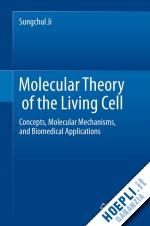
Questo prodotto usufruisce delle SPEDIZIONI GRATIS
selezionando l'opzione Corriere Veloce in fase di ordine.
Pagabile anche con Carta della cultura giovani e del merito, 18App Bonus Cultura e Carta del Docente
The book presents the first comprehensive molecular theory of the living cell ever published since the cell doctrine was formulated in 1838-1839. It introduces into cell biology over three dozens of key concepts, principles and laws imported from physics, chemistry, computer science, linguistics, semiotics and philosophy. The author formulates physically, chemically and enzymologically realistic molecular mechanisms to account for basic living processes such as ligand-receptor interactions, enzymic catalysis, force-generating mechanisms in molecular motors, chromatin remodelling, and signal transduction. Possible solutions to basic and practical problems facing contemporary biology and biomedical sciences have been suggested, including pharmacotherapeutics and personalized medicine.
After two years of pre-engineering training at the College of Engineering, Seoul National University in Seoul, Korea, the author obtained a scholarship in 1962 to study at the University of Minnesota, Duluth, receiving a Bachelor’s degree in chemistry and mathematics in 1965. The author received a Ph.D. degree in physical organic chemistry from the State University of New York at Albany in 1970. Between 1970 and 74, he was a postdoctoral fellow and a Research Assistant Professor at the Institute for Enzyme Research at the University of Wisconsin, Madison, studying the molecular mechanisms of oxidative phosphorylation in mitochondria. The concept of the conformon that plays a key role in the theory of the living cell described in the book was first formulated while the author was carrying out bio-theoretical research in Madison. He then spent 2 years at the Johnson Research Foundation at the University of Pennsylvania investigating the space-dependent NADH fluorescence signals from rat liver and brains as a function of metabolic and circulatory perturbations. Based on the results of these experiments, the author was invited to join a research group at the Max Planck Institute for Systems Physiology, Dortmund, West Germany, as a visiting scientist, between 1976 and 1979, returning to the US in 1979 as a Research Associate Professor at the Department of Pharmacology, University of North Carolina School of Medicine, Chapel Hill, NC. The author spent 3 years in Chapel Hill, elucidating the mechanisms of alcohol-induced liver injury using rat models. Since 1982, the author has been teaching and carrying out theoretical and experimental research in the Department of Pharmacology and Toxicology at Rutgers University, Piscataway, NJ, where the author formulated the Bhopalator model of the cell in 1983 and has been developing and applying it to pharmacology and toxicology ever since.











Il sito utilizza cookie ed altri strumenti di tracciamento che raccolgono informazioni dal dispositivo dell’utente. Oltre ai cookie tecnici ed analitici aggregati, strettamente necessari per il funzionamento di questo sito web, previo consenso dell’utente possono essere installati cookie di profilazione e marketing e cookie dei social media. Cliccando su “Accetto tutti i cookie” saranno attivate tutte le categorie di cookie. Per accettare solo deterninate categorie di cookie, cliccare invece su “Impostazioni cookie”. Chiudendo il banner o continuando a navigare saranno installati solo cookie tecnici. Per maggiori dettagli, consultare la Cookie Policy.